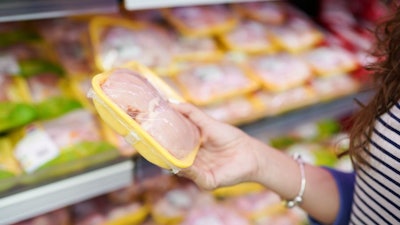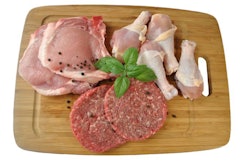
Innovation in organic and no-antibiotics-ever poultry feed continues to gain acceptance with consumers
Organic and no-antibiotics-ever (NAE) chicken in the U.S. is growing, while consumers continue to seek out convenience foods and an increasing amount of dark meat.
This is according to Chris DuBois, senior vice president-protein practice for IRI. DuBois spoke January 29 at the Feed Strategy Conference, presented by WATT Global Media at the International Production & Processing Expo (IPPE) in Atlanta.
In U.S. grocery stores and supermarkets, overall meat sales are flat. But chicken continues to grow; in 2019, chicken sales by value were up 1.5% and, by pounds, were up 0.6%, DuBois said.
“Growth and innovation are important,” he said. “If you look at protein since 1960, chicken has grown almost three times in terms of per capita growth.”
NAE chicken and turkey grew in the past year – by 2.3% and 8.4%, respectively – while NAE beef and pork sales were down. The three-year compound annual growth rate for chicken was 32.9%.
“No antibiotics ever across the proteins … has been so varied, but chicken in particular has changed the industry overall,” he said.
Organic chicken makes up a smaller part of the U.S. chicken market than NAE, but “it’s growing at a pretty good rate,” DuBois said.
“Organic is a smaller subset. I think there is a lot less headroom to grow in this, but you can begin to see that this is one of the big areas that’s powering U.S. retail right now. For the U.S. retailers that have gotten behind and supported NAE products or organic products on their shelves, they’re growing faster than retailers who don’t. Why is that? It’s because the growth rates are so substantial,” he said.
Convenience and the rise of dark meat
DuBois said value-added meat that provides convenience for the consumer “really matters and it really pays off.”
“One of the topics we always talk about is value-added meat because that’s where the growth is. Think sliced, diced, marinated, seasoned, dry rubbed. It’s growing at a rate of two to three times faster,” he said. “It’s all about making it easy for the consumer.”
DuBois added that dark meat cuts are driving overall chicken growth. In 2019, sales of boneless breast meat cuts were down 3.4% while boneless thigh cuts were up 10.5% – signaling a change in consumer tastes from years past.
“The other big piece, and it’s something that’s flying a little bit under the radar, but it’s just beginning to catch a lot more attention now, is the rise of dark meat,” he said. “This begins to change what the chicken industry has been working on for the last 20, 30 years.”
Chicken drives other purchases
DuBois said that meat sales are not just good for the meat industry – they drive purchases overall.
“When chicken is in the basket, it’s almost $99 for that total basket,” he said. “When chicken’s not in the basket, $44.50 is about the average. So, when people are choosing to go to that store to buy meat and chicken, that’s a big difference. Chicken brings in consumers and it brings in the dollars.”
Within the past year, 47% of U.S. consumers have purchased NAE chicken – up 14 points from the previous year. Organic chicken has seen a slight gain in market penetration as well.
“So, what chicken’s been doing – the innovation, the growth on the feed side – continues to build household acceptance that’s driving some growth,” he said.
And consumers that choose to purchase NAE chicken are loyal to the label.
“When they start buying this feed type, they’re going to continue to buy it. It’s not an experimentation,” he said.
Keys to success
How do chicken producers continue to gain market share and acceptance by consumers?
DuBois said the chicken meat industry should deliver on higher emotional attributes, such as humanely raised meat and satiety.
“The sustainability message gets through to consumers,” he said. “They care and they understand.”
He added that the industry should share its story with consumers and highlight the good things it is doing.
“Continue to make sure you’re getting full credit for all the good work that’s being done,” he said, “because there is a great story, and the more we tell it, the more we share it from an industry side, a company side, a media side, the more consumers are going to get that.”








